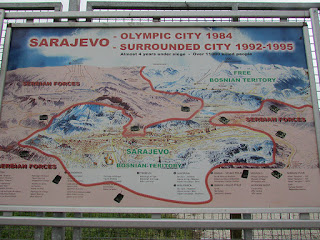Once I was in Sarajevo in 1984, a few days after the end of the Winter Olympics.Those were happier days; we were young and carefree.We lived in the same country and we haven't thought about war.Thirty years later, Sarajevo is not the same city, and we have also changed. I tried not to think about the war and created classifications among people; unfortunately the reminders are everywhere. It was raining (snowing) whole weekend, so the atmosphere seemed even sadder. But Sarajevo is a special city, whose citizens are accustomed to the coexistence of different nations and religions. I hope one day Sarajevo will be an Olympic city again.
City tour should begin at Basčaršija.
The
name Baščaršija (Turkish = main market, trading area) is now used for the
entire artisan-trade area in the heart of old Sarajevo.
Sebilj
-kiosk shaped public
fountain, a major symbol of the city. Havadža Durak Mosque, better known as Baščaršija Mosque
Morića Han (inn) is only remaining caravanserai.
Old Clock Tower is 30 meters high and it is the only public clock in the world
that keeps lunar time (“à la Turk”) to indicate the times for the daily prayers.
The Gazi Husrev Beg LibraryKurshumli Madrasah- Kuršumlija
The
Gazi Husrev-Beg Madrasah- is the oldest educational institution of its kind in
Bosnia and Herzegovina.
Gazi Husrev Bey’s Bezistan – market place-was at the center of trade in
Sarajevo during the Ottoman period.
The Old Jewish Temple, also known as the Old Synagogue and the Great Temple (Il Kal Grandi)
It was built at the end of the 16th century. Today it is the Jewish Museum of Bosnia and Herzegovina and an annex of the Museum of Sarajevo.
"Sarajevo Meeting of Cultures" is a border between two cultures - two empires. On one side Ottoman architecture ends and on the other side Austro - Hungarian architecture starts.
Ferhadija – the popular pedestrianized street, borders with the Ottoman part of the city.
The
Cathedral of Jesus’ Sacred Heart, was built in 1889. Inspiration for the design
of cathedral was the Notre Dame Cathedral in Dijon and St.Teyn Cathedral in
Prague.
Sarajevo Rose
A few meters from this bridge Gavrilo Princip assassinated Archduke Franz Ferdinand and his
wife Sofie. This incident, known as the Sarajevo Assassination, led to the
beginning of the First World War.
City Hall (Vijećnica)
is the most extravagant building constructed in Sarajevo during
Austro-Hungarian occupation.The unique Pseudo-Moorish architectural style is
the perfect blend of the Orient and Occident.
The
natural monument, Vrelo Bosne- about 15 kilometers from the center of Sarajevo.
It is the source of the Bosna River. Has been a favorite outing destination for the past 100 years.
Modern
architecture:
Sarajevo City Center
The
twin towers- commonly called Momo (Serbian name) and Uzeir (Bosniak name).Sarajevo City Center
The Academy of Fine Arts- one of loveliest buildings.It was originally built to
serve as an Evangelical Church.
Very
cool bar -Zlatna ribica
The
Yellow Fortress-one of the fortifications that made up the defensive wall of
the old town, Vratnik.
How to start your morning in Sarajevo? Of course with the Bosnian coffee.Bosanska kahva is served with Turkish delight –rahatlokum.
How to start your morning in Sarajevo? Of course with the Bosnian coffee.Bosanska kahva is served with Turkish delight –rahatlokum.
And of course, you can not leave Sarajevo and not
try burek, sirnica, zeljanica or krompiruša.
The legend
says that any traveler who drinks water from it is sure to return to Sarajevo.
:)
:)




















































































No comments:
Post a Comment